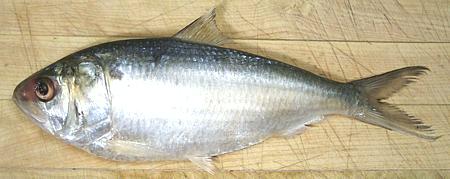 [Sardinella aurita (fb Round Sardninella),
Sardinella maderensis (fb Maderensis Sardinella)]
[Sardinella aurita (fb Round Sardninella),
Sardinella maderensis (fb Maderensis Sardinella)]
Spanish Sardine is supposed to be S. aurita, but the photo specimen, sold as such, looks more like S. maderensis to me. aurita lives all along both Atlantic coasts, the Caribbean and the Mediterranean in both tropical and temperate zones. Maderensis is an East Atlantic and Mediterranean fish. While both species can grow to over 12 inches, the photo specimen was 10-1/2 inches long, 3 inches high, 1-1/4 inches thick and weighing 7-1/2 ounces.
More on Sardines.
This is a rather tasty fish, but almost inedible. It's a very bony fish with not a lot of flesh on it, and what there is all full of long, sharp, almost invisible pinbones - and it has scutes near the tail as well. I suppose this is why they only charge 2008 U.S. $1.29/pound at the local Philippine fish market - and that was factory cleaned - gills and guts removed.
So what is to be done with such a fish? Well, it's somewhat oily and medium strong in flavor, so it's suitable for pickling. An acidic pickle will soften all those pinbones into edibility.
Scales: This fish is completely covered with large scales that are easy to scrape off without flying around too much.
Fillet: The filleting method we use on most fish is difficult because all the pinbones resist cutting. The practical way is the "one stroke" method. Make a cut behind the head and from there just shave the fillet off from head to tail. Go deep at the top and forget about anything below the centerline - there's nothing there.
Yield: A 7-1/2 oz fish yielded only 3 oz (40%), but at 60 cents per fish it's not that expensive.
Skin: The skin shrinks severely when cooked by any method, but if steamed it will soon come loose and can be pulled off if desired.
Stock The head and bones make a somewhat strong but not unpleasant fish stock. There will be a significant amount of oil to be separated from the stock - use your gravy separator.
sf_sardspz 080607 - www.clovegarden.com